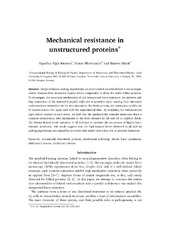| dc.contributor.author | Jónsson, Sigurður Ægir | eng |
| dc.contributor.author | Mitternacht, Simon | eng |
| dc.contributor.author | Irbäck, Anders | eng |
| dc.date.accessioned | 2013-06-20T08:39:09Z | |
| dc.date.available | 2013-06-20T08:39:09Z | |
| dc.date.issued | 2013-06-18 | eng |
| dc.Published | Biophysical Journal 104(12): 2725-2732 | eng |
| dc.identifier.issn | 1542-0086 | |
| dc.identifier.other | http://arxiv.org/abs/1304.7991 | eng |
| dc.identifier.uri | https://hdl.handle.net/1956/6710 | |
| dc.description.abstract | Single-molecule pulling experiments on unstructured proteins linked to neurodegenerative diseases have measured rupture forces comparable to those for stable folded proteins. To investigate the structural mechanisms of this unexpected force resistance, we perform pulling simulations of the amyloid β-peptide (Aβ) and α-synuclein (αS), starting from simulated conformational ensembles for the free monomers. For both proteins, the simulations yield a set of rupture events that agree well with the experimental data. By analyzing the conformations right before rupture in each event, we find that the mechanically resistant structures share a common architecture, with similarities to the folds adopted by Aβ and αS in amyloid fibrils. The disease-linked Arctic mutation of Aβ is found to increase the occurrence of highly forceresistant structures. Our study suggests that the high rupture forces observed in Aβ and αS pulling experiments are caused by structures that might have a key role in amyloid formation. | en_US |
| dc.language.iso | eng | eng |
| dc.publisher | Elsevier | eng |
| dc.subject | intrinsically disordered proteins | eng |
| dc.subject | mechanical unfolding | eng |
| dc.subject | Monte Carlo simulation | eng |
| dc.subject | Monte Carlo methods | eng |
| dc.subject | Alzheimer's disease | eng |
| dc.subject | Parkinson's disease | eng |
| dc.subject | Neurodegenarative diseases | eng |
| dc.subject | amyloid fibrils | eng |
| dc.subject | Aggregation | eng |
| dc.subject.ddc | 572.33 (DDC23) | eng |
| dc.title | Mechanical resistance in unstructured proteins | eng |
| dc.type | Peer reviewed | |
| dc.type | Journal article | |
| dc.description.version | acceptedVersion | |
| dc.rights.holder | Copyright 2013 Biophysical Society. All rights reserved. | |
| dc.identifier.doi | https://doi.org/10.1016/j.bpj.2013.05.003 | |
| dc.identifier.cristin | 1071262 | |
| dc.source.journal | Biophysical Journal | |
| dc.source.40 | 104 | |
| dc.source.14 | 12 | |
| dc.source.pagenumber | 2725-2732 | |
